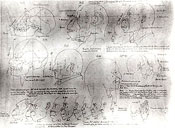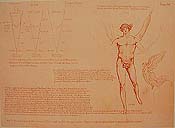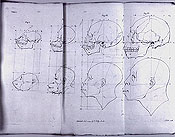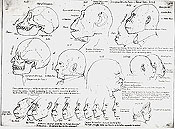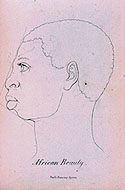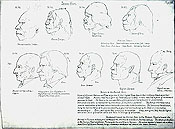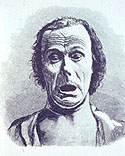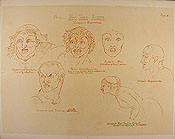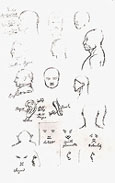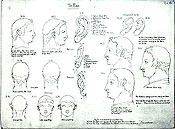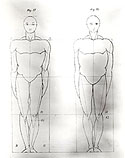The browser will either open the file, download it, or display a dialog.
|
|
Life Drawing from Ape to Human: Charles Darwin's Theories of Evolution and William Rimmer's Art Anatomy |
|||||
|
The impact of Darwin's theories of evolution on the visual arts of nineteenth-century America has been considered primarily in the context of American landscape painting. Citing the year 1859, which marked the death of world-renowned naturalist Alexander von Humboldt, the London publication of Charles Darwin's Origin of Species, and the first public exhibition in New York City of Frederic Church's monumental painting, The Heart of the Andes, Barbara Novak and Stephen J. Gould describe the links between Humboldt and Darwin and the landscape paintings of Church.1 Darwin's theories, however, also had a significant impact on the development of life drawing in the United States. William Rimmer's Art Anatomy, first published in 1877, represents the most comprehensive anatomy book issued in the United States at the time and provides new insight into the influence of Darwin's evolutionary theory on artistic practice.2 Rimmer's drawing book is largely unknown owing to the ethnographic nature of the publication, yet it is precisely this approach that furthers our understanding of the reception of Darwin's theories in the United States during the 1870s. | |||||
|
To fully appreciate the revolutionary nature of Rimmer's Art Anatomy, it is essential to understand the broader context of drawing books available in the United States when the work appeared.3 Despite the prevalence of American drawing books—an estimated 145,000 were in circulation in the United States prior to the Civil War— Rimmer's Art Anatomy was unprecedented for its extensive descriptions and drawings of the anatomy of men, women, and children and for its associations with Darwinian theories of evolution and emotion in man and animals.4 Rimmer clearly incorporated elements of existing American anatomy texts. Rimmer's first drawing book, Elements of Design, 1864 (fig. 1), recalls the approach to male proportions in British-born printmaker and artist John Rubens Smith's A Key to the Art of Drawing the Human Figure, 1831, and he included similar diagrams in the final section of Art Anatomy (fig. 2) devoted to depicting proportions in men, women, and children. Winslow Homer's graphite drawing of a male nude, likely produced while he briefly studied drawing in New York City around 1860, reveals similar proportions for the figure, suggesting such a method was known to practicing artists.5 | |||||
| The first section of Art Anatomy depicts the head and skull in a manner that suggests Rimmer's awareness of the most popular nineteenth-century publication of its kind, John Gadsby Chapman's American Drawing Book (first issued in 1847 and in numerous subsequent editions through the 1870s). On page two, Rimmer includes several views of the human head looking up and down, an approach that Chapman clearly copied from an earlier French drawing book, Jombert's Methods of Drawing (1755). Exercise No. 18 on page two suggests that Rimmer superimposed Chapman's view onto one diagram, for which he instructs the reader to find the circles and describe the form of the head seen from above and below. | ||||||
| By devoting thirty plates in the first section of Art Anatomy to rendering the human head, Rimmer's text explores the subject in far greater depth than either Smith or Chapman. Indeed, the closest American source for Rimmer's distinctive style of outline drawings and discussion of the head is found in Louis Bail's The Human Head: A Correct Delineation, which appeared in 1859. Bail, Professor of Drawing at Yale, describes the impact of foreign immigration upon the American character, an issue clearly of interest to Rimmer in his analysis of ethnic types as a corollary to the study of the human head.6 Following Bail's assessment of the pertinent characteristics of the French, English, Germans, and Italians, he proffers his interpretation of the typical American: "…the vast tide of emigration pouring to the American shores, by means of which each individual nation leaves its impress of its most prominent traits upon the general character, has developed, or rather is developing, the most original, diversified, marked, and interesting character in the American national character."7 | ||||||
|
|
||||||
| Bail's and Rimmer's concern with drawing the figure in profile is greatly indebted to the study of physiognomy, the practice of identifying personality types based upon salient physical features. Developed during the eighteenth century in France and England and widely disseminated in books and prints, physiognomy appealed to many nineteenth-century American artists.8 Profiles figured prominently in one of the most influential treatises on the subject, Charles Lavater's Essay on Physiognomy, which was included in the libraries of all major American art academies by the mid-nineteenth- century.9 As discussed by Elizabeth Johns, the American genre painter William Sidney Mount, for example, frequently relied upon representing different types in his paintings of Raffling for the Goose or The Painter's Triumph, both of which suggest the artist's familiarity with popular notions of personality as revealed in distinctive facial details.10 | ||||||
| Physiognomy dovetailed with another thrust of Rimmer's method of anatomical drawing, that of the study of comparative anatomy. The most comprehensive treatise on comparative anatomy available in English and included in the library of the National Academy of Design by 1852 was Pieter Camper's Works on the Connexion (sic) Between the Science of Anatomy and the Arts of Drawing, Painting, and Statuary, first published in Amsterdam in 1791 and translated into English in 1794. (fig. 3) As astutely discussed in the context of Barbara Stafford's book, Body Criticism, Camper renders various human, ape, and animal skulls from a perspective with varying vanishing points, thus the optical axis is always at right angles to the object rendered.11 The resulting illustrations are highly abstract and as such extremely potent in suggesting that each example is a distillation of fact. In Table One from Camper's treatise (fig. 3), the author compares the facial angles of skulls of various races and those of animals. Rimmer echoes that approach on page four (fig. 4) of his first section of Art Anatomy devoted to the delineation of the human head. | ||||||
| Prior to the publication of Rimmer's Art Anatomy, no American drawing book had attempted to depict the evolution from ape to human in a manner consistent with that expressed in Darwin's The Descent of Man of 1871. Rimmer's approach, as depicted in Art Anatomy (fig. 4), represents the varying facial angles of the skull from ape to human, thereby implying progressive evolution. To quote Darwin's theory in the Descent of Man, "The main conclusion here arrived at, and now held by many naturalists who are well competent to form a sound judgment is that man is descended from some less organized form." That form is a "hairy, tailed quadruped, probably arboreal in its habits, and an inhabitant of the old World." Darwin expresses his theory in a visual way by describing a "less organized form." Rimmer picks up where Darwin leaves off and provides a graphic description of how that form changes before our eyes. To drive the point of the drawing home, beneath his scale of profiles from ape to man, Rimmer poses the question to the anatomy student: "Ascending: At what point does the animal disappear? Descending: At what point does the Man disappear?" | ||||||
|
|
||||||
| To answer his rhetorical question, Rimmer posits nearby that, "The details of the face become more Manlike as the outline approaches the vertical," an observation that reflects his study of facial angles in both animals and man. In the upper right corner of the same page of Art Anatomy (fig. 4), Rimmer includes a drawing of a man labeled "ape-like" adjacent to a profile labeled "Negro" with a line indicating facial angle for the ape-like man. Rimmer stops short of making any aesthetic judgment between the two renderings. Bail, who was similarly concerned with facial angles, openly described his assessment of the facial angles of the model Caucasian and the African Beauty. (fig. 5) In Bail's text accompanying the plates reproducing both profiles, he maintains: "The angle of the Caucasian face is very obtuse, in fact, it approaches a straight line. That of the African face, is nearly a right angle. The form of the head exhibits a contrast, if possible, yet more striking, and proves the value of the study of the skull, and also the beauty, symmetry, and dignity, its correct formation gives the whole man."12 | ||||||
| Rimmer essentially evades the issue of ideal facial angles in favor of noting that each race exhibits ideal and debased heads. (fig. 6) To distinguish between what Rimmer terms debased heads of different ethnic origins, he compares the profiles of Indians indigenous to Massachusetts, Florida, California, and Peru, and asserts that: "… heads of different Nations and Types differ less in their highest Types than in their ordinary Heads or in their debased Heads. As every race has a form of Head peculiar to itself, so every race has a form of development peculiar to itself. The Ideal is representative of the general character, and is impersonal."13 In distinguishing between debased and ideal heads, Rimmer includes drawings based on his study of skulls in the Massachusetts Zoological Institute and from life. The Anglo-Saxon head reproduced on page twenty-eight, for example, (fig. 6), was based on his father's profile, as rendered in a pencil sketch for the work.14 Yet Rimmer goes on to note the change of form from "Anglo-Saxon to Anglo-American, in which the proportions change to the Indian form," without making any qualitative statement about the relative ideals of either head. | ||||||
| Rimmer and Darwin subscribed to progressive evolution; however, both men refused to support the commonly held belief that the cranium of the European Caucasian was larger than that of the African and thus a sign of superior intelligence. As discussed by Gould in The Mismeasure of Man, the study of polygeny was keenly developed in the United States during the nineteenth century largely owing to the efforts of the Swiss-born naturalist Louis Aggasiz (1807–1873) and the Philadelphia physician and scientist, Samuel George Morton, who published Crania Americana and Crania Aegyptiaca in 1839 and 1844, respectively.15 Despite Darwin and Rimmer's acceptance of progressive evolution, both were proponents of abolitionism, which Darwin described in his letters.16 In Plate 13 of Art Anatomy, Rimmer states his firm belief that: "The size of the Brain has no special connection with the strength of the understanding…."17 In 1863 Rimmer's drawing in the Museum of Fine Arts, Boston collection celebrated the 54th Regiment of the Union Army, the first all-black battalion, which was led by a white Union Colonel Robert Shaw in a manner that celebrates their heroic forms as seen from behind and thus without any distinguishing facial features.18 That same regiment later commanded attention in the city of Boston when Augustus Saint-Gaudens's monumental bronze relief, the Robert Gould Shaw Memorial, was prominently displayed outside the statehouse in 1897. | ||||||
| Following directly upon the study of the human head, Rimmer includes in Art Anatomy six pages describing the emotions and their expression as portrayed by the human visage. Here Rimmer reveals his close study of the human elements of Darwin's treatise, The Expression of the Emotions of Man and Animals of 1872. In Chapter Twelve, Darwin highlights the emotions of "Surprise, Astonishment, Fear, and Horror," with accompanying wood engravings based on original photographs by Dr. Duchenne de Bologne. Recalling Darwin's Figure Twenty-eight illustrating Terror (fig. 7), Rimmer's central figure from page thirty-one (fig. 8) illustrates his own rendition of the emotion with special emphasis upon the "distension of all the features," and in particular, the muscles of the forehead and the appearance of the lower lip. | ||||||
| That Rimmer's method of study was known to a wide range of artists on the practicing spectrum is demonstrated by his well-attended anatomy lectures delivered in Boston, New York, and Providence. Initially pursuing a variety of professions as a shoemaker, printmaker, typesetter, doctor, and sculptor, Rimmer eventually attracted the support of Stephenson Higginson Perkins, who furthered the artist's reputation at home and abroad. Rimmer's acclaim eventually spread to New York City, where he was invited to lecture at the National Academy of Design in January 1866. His paintings, such as Flight and Pursuit (1872), were never his strong suit, and he began to specialize in anatomy instruction. In 1866, Rimmer was invited to become the first director of the School of Design for Women at Cooper Union for the Advancement of Science and Art, founded in 1859 by Peter Cooper. He served in that capacity for four years until 1870, introducing a comprehensive course of life drawing that included the controversial practice of women drawing the nude male model.19 Consternation over Rimmer's commitment to providing the same drawing instruction for female students as that which was standard for males may have contributed to the sense of dissatisfaction with Rimmer's ability to teach women practical applications of drawing. Whatever the underlying cause of complaint with Rimmer, the trustees and the administration began to undermine his authority. Rimmer defended his curriculum, which heavily favored his approach later described in Art Anatomy, and urged the trustees in a letter dated 4 April 1870 to consult with the following artists, who had been students of his or had attended his lectures. First among those listed is Frederic Church (1826-1900), followed by John LaFarge (1835–1910), Seymour Guy (1824-1910), Worthington Whittredge (1820–1910), Sanford Gifford (1823–1880), William Hays (1830–1875), Edward Mooney (1813–1887), John Richard (active in the U.S. from 1841–1868), and John Frederick Kensett (1816–1872) who, Rimmer wrote, "is interested in the success of the school."20 Rimmer failed to persuade the trustees of the value of his teaching, and he eventually returned to Boston, where anatomy lectures provided the main source of his income. | ||||||
| Rimmer later found employment during the winter of 1875–76 at the Massachusetts Normal Art School, an institution charged with training future instructors to teach drawing in the public schools. Walter Smith, who had been appointed the director of drawing for the City of Boston and the state director of art education in 1871 as part of the Massachusetts Drawing Act, eventually disputed Rimmer's analysis of anatomical drawing. Their personalities clashed in a barbed exchange concerning the distinction between structural and art anatomy. Smith challenged Rimmer to describe the difference between the two approaches. Rimmer maintained that although structural anatomy was inextricably linked to art anatomy, structural anatomy was anatomy "viewed abstractly without reference to art." In Rimmer's words: "Art anatomy relates, not only to structural anatomy, but to the form of the whole body, as representative of a type of man or animal; to the changes of form resulting from, and incidental to, the uses of the several parts of the body, upon the basis of the structural relation."21 Rimmer ultimately argued for changes of form that were consistent with his understanding of Darwin's evolutionary theories. To put it another way, structural anatomy was the inevitable result of evolution, as Rimmer maintained, "viewed abstractly without reference to art." Art anatomy, such as that he laid out in the elaborate plates of his eponymous drawing book, involved aesthetic choices made in rendering the figure, frequently taking into consideration evolutionary theories of Darwin. Their rift hastened Rimmer's resignation from the Normal Art School. Until his death in 1879, he continued to teach men and women at his own school and eventually taught drawing and painting at the School of the Museum of Fine Arts, which began offering art classes in 1877. | ||||||
| Rimmer's influence spread to professional artists and amateurs alike. Prior to the publication of Art Anatomy,, thirty-six of his lectures compiled from notes taken by his students and himself were published by The Providence Journal.22 Several groups of previously unpublished anatomical drawings by the quintessential Hudson River School landscape painter, Frederic Church, demonstrate the range of Rimmer's influence. Church depicts a profile that recalls Rimmer's ideal Anglo-Saxon head illustrated in Exercise No. 188. (fig. 9) Whereas Rimmer included the inscription "Highest average outline-English," Church writes "Englishman." At the right edge of the same sheet, second row from the top, Church renders an Indian in profile that is reminiscent of Rimmer's Lesson No. 189. (fig. 6) On the same sheet are several studies from another plate of Rimmer's drawing book (fig. 9), describing the ear as seen by itself and from behind. That detail also appears in Rimmer's drawing book with reference to the helix (fig. 10), an observation discussed and illustrated by Darwin at the outset of The Descent of Man. The particular passage from Darwin cites the observations of the "celebrated sculptor, Mr. [Thomas] Woolner (1825–1892)," who informed the naturalist "of one little peculiarity in the external ear, which he has often observed both in men and women," a fact that may have appealed to Rimmer's sensibilities as a sculptor.23 | ||||||
|
Rimmer was dedicated to teaching amateurs; an advertisement in his earlier drawing book, Elements of Design, indicates that he offered classes to both women and men in Boston during the 1860s. As part of the stipulation for teaching female amateurs in a private class held in Milton, Massachusetts near Boston, Rimmer's drawings on the blackboard would not be erased so that they would be available for students to trace. Emma Cross represents one of the many female amateurs who carefully followed Rimmer's Art Anatomy. She began her training in drawing in the public schools of Manchester, New Hampshire and eventually settled in Malden, Massachusetts in the 1880s. Although Cross could not have attended the celebrated anatomy classes of Rimmer, who died in 1879, she dedicated herself to tracing Rimmer's illustrations from Art Anatomy onto sheets of onionskin paper in a series of thirty drawings housed at the American Antiquarian Society as part of the Cross family archive.24 One example represents Rimmer's page twenty-eight A, which contains the lesson drawn by Church. (fig. 11) |
||||||
| Rimmer's anatomy treatise reveals a scientifically informed approach to understanding the human form—an approach that was evidently distilled from his method of teaching life drawing. This is further supported by the following passage from The Boston Sunday Herald published before 1870. When the French government sent Armand Dumaresq to examine educational institutions in the United States he reported upon his meeting with Rimmer, with whom he was greatly impressed. Dumaresq wrote of the encounter: "In order to give me an idea of his mode of instruction, Dr. Rimmer drew a chimpanzee head with surprising facility, presented the African and Caucasian types, then the different modifications from childhood to manhood, the difference between the head of man and of woman, coming last to the female head, which changes with age towards a masculine character." | ||||||
| With the publication of Darwin's The Descent of Man in the United States in 1871, Rimmer's discussion of the evolution from ape to human clearly had a significant impact on American artists' study of the human form. Seeking to assist students in the renderings of the human figure, based on average facial angles and proportions, Rimmer attempted to distinguish between the ideal and the aberrant in ethnic models, and in so doing, believed he remained true to his abolitionist stance. His incorporation in Art Anatomy of comparative anatomy and the most recent ideas about evolution not only offered a new approach to the instruction of life drawing, but also sought to challenge some of the more deleterious stereotypes found in earlier studies of physiognomy. | ||||||
|
|
||||||
|
1. Barbara Novak, Nature and Culture, American Landscape and Painting 1825-1875. (New York: Oxford University Press, 1995); and Stephen. J. Gould, Franklin Kelly, et al., Frederic Edwin Church, (Washington, D.C.: National Gallery of Art, 1989). 2. William Rimmer, Art Anatomy. Eighty-One Plates. (Boston: Houghton, Mifflin, and Company, 1884). The preface of this later edition states that the book was originally published in 1877, when a small edition was printed by the heliotype process. According to the publishers' note: "two years later the plates of the book and such of the copies as remained were destroyed by fire. The original pencil drawings, from which the heliotypes were made, were fortunately unharmed, and it is from these, now in the possession of Dr. Rimmer's family, that the accompanying fac-simil [sic] reproductions, upon the same scale, by the albertype process, have been made. Nothing has been omitted, and every pain has been taken to put the student in possession of a faithful copy of Dr. Rimmer's original drawings." The facsimile publications of 1884 are in the libraries of the Museum of Fine Arts, Boston, and the Metropolitan Museum of Art, New York. Many of Rimmer's original drawings for Art Anatomy are in the Department of Prints, Drawings, and Photographs at the Museum of Fine Arts, Boston. 3. For an introduction to American drawing books of the nineteenth century, see Peter Marzio, The Art Crusade. An Analysis of American Drawing Manuals 1820-1860. (Washington, D.C.: Smithsonian Institution, 1976); and Elliot Bostwick Davis, Training the Eye and the Hand: Drawing Books in Nineteenth-century America. Ph.D. dissertation, (New York: Columbia University, 1992). 4. Marzio, 1976, p. 1. For information on Rimmer, see Truman H. Bartlett, The Art Life of William Rimmer: Sculptor, Painter, Physician. Boston and New York: Houghton Mifflin, 1890. See also, Jeffrey Weidman, Neil Harris, and Philip Cash, William Rimmer. A Yankee Michelangelo, Exh. Cat. Brockton, Brockton Art Museum/Fuller Memorial (Hanover and London: University Press of New England, 1985). 5. For a discussion of Winslow Homer and his relationship to American drawing books, see Elliot Bostwick Davis, "American Drawing Books and Their Impact on Winslow Homer," in Winterthur Portfolio, Vol. 31, Numbers 2/3 (Autumn 1996): 141-163. 6. Louis Bail, The Human Head: A Correct Delineation of the Anatomy, Expressions, Features, Proportions, and Positions of the Head and Face: With Numerous Plates and Explanatory Text. (New Haven: By the author, 1859). pp. 29-30. 7. Bail, 1859, p. 19. 8. For European artists, see Mary Cowling, Mary. The Artist as Anthropologist. The Representation of Type and Character in Victorian Art. (Cambridge, England: Cambridge University Press, 1989). 9. See "Drawing Books and Art Academies in the United States," in Davis, 1992, chapter three, pp. 32-63. 10. Elizabeth Johns, American Genre Painting. The Politics of Everyday Life, (New Haven: Yale University Press,1991). See, for example, Mount's Raffling for the Goose Exh. cat. Metropolitan Museum of Art, New York; Johns, 1991, p. 39, fig. 8; or The Painter's Triumph Exh. cat. Pennsylvania Academy of Fine Arts, Philadelphia; Johns, 1991, p. 43, fig. 9. 11. Barbara Stafford, Body Criticism. Imagining the Unseen in Enlightenment Art and Medicine, (Cambridge: MIT Press, 1991). 12. Bail, 1859, p. 19. 13. Rimmer, 1884, p. 4. 14. The pencil sketch of Rimmer's father is reproduced in Bartlett, 1970, fig. 4 p. 2. See also Weidman, Harris, and Cash, 1985, p. 103. 15. Stephen J. Gould, . The Mismeasure of Man. (New York: W. W. Norton, 1996) p. 74. 16. Gould, 1996, p. 69. 17. Rimmer, 1884, pl. 13. 18. William Rimmer, 54th Regiment of the Union Army, Drawing, Boston, Museum of Fine Arts, Gift of William R. Ware. 19. For attitudes in Boston toward women artists in anatomy classes with male models, see E. E. Hirshler, A Studio of Her Own. Women Artists in Boston, 1870 –1940, exh. cat., Museum of Fine Arts, Boston, 2001, pp. 11-12. See also Lincoln Kirstein, "William Rimmer. His Life and Art," The Massachusetts Review, Summer 1961, p. 9. 20. Letter of 4 April 1870 from William Rimmer "To the Ladies of the Advisory Committee and the Trustees of the School of Design," New York, Cooper-Union Archives, Folder 2, C/5DB/C778C/Box.w 21. Bartlett, 1882, p. 40. 22. For a selection of abstracts of Rimmer's courses taught in Providence, see Bartlett, 1882, pp. 66-78. 23. Darwin, 1974, p. 15. 24. For Emma Cross's background, see Diana Korzenik, Drawn to Art, (Hanover and London: University Press of New England, 1985). |


